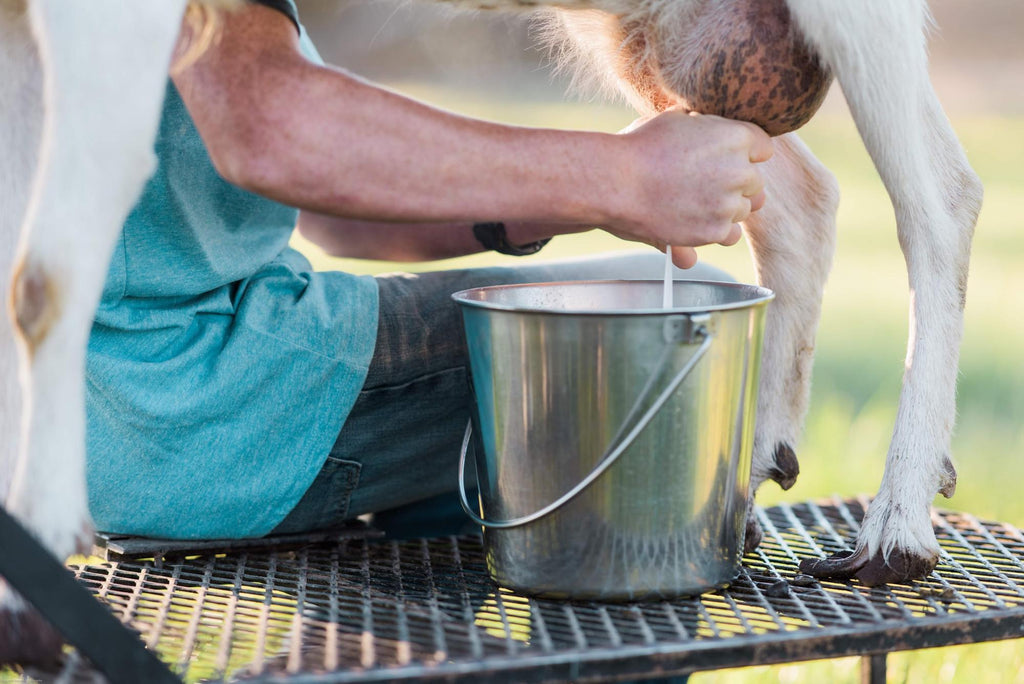Meet Our Goats
Meet the Goats at Bend Soap Co.
As our business has grown, so has our need for fresh goat milk. We’ve expanded our herd and moved it to our sister farm across town that is more accommodating to an ever-increasing herd of goats. In an attempt to use as many local ingredients as possible and support our community, we also obtain some fresh goat milk from select goat milk dairies around Central Oregon. Read on to learn the ins and outs of managing our herd of goats.
The Herd
Dwight had always loved the idea of having goats, and our story really begins when he first started buying goat’s milk for the kids to drink after they were weaned. When the price per gallon began to increase (and we kept having children), Dwight decided to buy a few milk goats. In February of 2007, we welcomed our first goats to the farm: Molly, Velvet, and their 3 kids.
Today, as Bend Soap Company has grown and our uses for fresh goat milk have expanded, we’ve added many more goats to our herd. We now have a mix of Nubian, Saanen, Alpine, and LaMancha goats.
The Buck
A male goat is called a “buck” or a “billy”. In 2014, we adopted our very first billy goat, Mr. Alpine, who is the most skittish thing you've ever seen. Even still, he’s loved and adored by all of us! We must have a buck present in order to breed our does and have new baby goats (kids) each spring. New billy goats are added every 1-2 years to keep breeding at its prime.
The Does
Next we have our female goats which are called “does”. There are fifteen milk does right now including our beloved Angel, Coraline, Patches, Patch (her daughter), Goldy, Millie, and Friendly. They are all wonderful milk does who have been giving us milk for years. There was once a year when we had nearly 100 goats on the property, with several ready to deliver more! This was a bit extreme, even for us, and further justified our decision to begin purchasing fresh goat milk from other local dairies.
Kids Galore
Every spring, there can be anywhere between 20 and 40 kids (or baby goats) on the farm. On rare occasions, we’ve even had does kidding all the way up into July.

Caring for Our Goats
The Milking Routine
There are several steps involved in milking our goats. First, grain is set out on the stanchions. Then the milking machines are prepped. Next we let the milk goats out to a separate pen to make sure each one is milked. One by one, they’re loaded up to the milking station, milked (while getting their fair share of grain), and then let back out into the big pen.
In the winter when the does are being bred, we slow down our milking routine to just once a day. Goats don’t have to be pregnant to produce milk. When they are pregnant, we stop milking the goats at least two months leading up to their due dates so that they can rest and have plenty of milk for their little ones.

Their Feed
Hay and alfalfa grown on our farm and other rural farms across Central Oregon provide the foundational food for our goats. We’ve had a wonderful hay crop on our farms for years but often need to supplement with other farm crops. The hay in the Central Oregon area is often shipped all over the country because of its high nutrient value and growing conditions which have little mold and high yield.
We also give each milking doe a ration of grain whenever they’re milked. This grain helps with their milk production and hormone levels and is a special treat they look forward to with each milking.

Their Supplements
Just like us folks who don't get all we need from the food we eat, there are certain nutrients that the goats need in addition to the hay they consume. The area we live in tends to be low in selenium, an important mineral needed for the development of healthy baby goats. Because of this, we give the goats a free form mineral supplement (their vitamins!), especially during pregnancy. This helps to produce healthy and strong offspring and great milk.
Disbudding
Horns grow on both male and female goats. In the wild, these horns would be more necessary for protection, but not here at their home on the farm. We dehorn our goats when they’re young so that their horns don't get stuck in the fences. This also keeps them from being able to injure one another.
Trimming Their Hooves
Just like how humans have fingernails that need to be regularly trimmed, goats have hooves that need to be maintained and groomed. Without proper trimming, their hooves will grow long and may cause the goats to walk poorly or have joint troubles. This trimming can be done with either a special pair of trimming scissors or a razor blade which is Dwight's preference.
Breeding Season
We try to breed a new doe when she has reached about 70% of her full weight. Before that time, it seems to be too early. We typically breed our does to Nubian, Boer, and Alpine billy goats and love seeing the difference in the kids each year.

Kidding
Kidding season (when the baby goats are born) is in the spring, typically between February and June. Sometimes the first-year does need a bit of extra help having the kids latch on, which we find to be a fun chance to be with the new kids.

It’s very common for goats to deliver twins — more common than a single kid or even triplets — and we’ve had our fair share of all three and have even had a goat delivery quads (4)! We like to leave the kids on the does for their first eight weeks and then begin to wean them off while we start picking back up with the milking schedule.
Our Motto: Happy Goats Produce Great Milk
It’s been quite a journey since adopting our first milk goats back in 2007, and our little herd of goats has certainly grown over time. We’re big believers in the idea that happy, healthy goats produce great milk, so going the extra mile to care for our goats is something that comes second nature to us. The top notch care we deliver to our goats shines through in the quality of the goat milk soap products we craft; give our goat milk soap and milk bath products a try to see and feel the difference for yourself.

